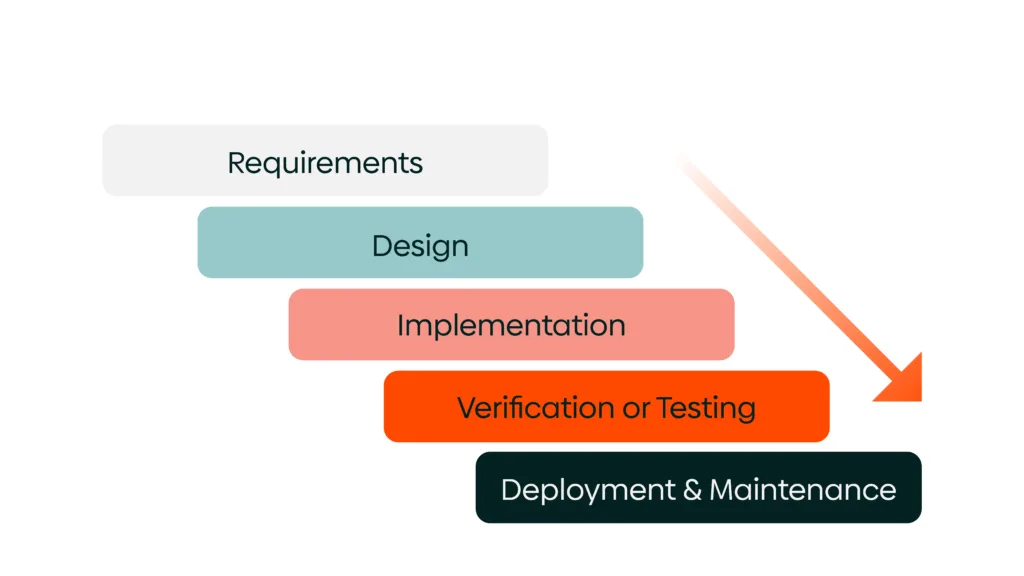
In a Waterfall, water falls in a downward motion with no way of returning. Waterfall testing employs a similar concept, where tests occur in linear and sequential phases.
Akin to a waterfall, each stage in the waterfall model flows into the next. So, the output of one phase is the input for the subsequent one.
In this blog, we will see the core aspects of waterfall in testing and discuss its advantages, drawbacks, and ideal use cases.
Understanding Waterfall Testing
To understand Waterfall in regard to testing, we first must understand Waterfall Model of software development.
Waterfall Model is a linear application development model with rigid phases. In Waterfall Model, phases occur in a sequence, and it doesn’t allow developers to return to previous steps. Hence, the model is compared to a waterfall.
While developing a system using the waterfall development methodology, we first divide the development process into distinct stages.
A similar process takes place in this form of testing, where requirements are meticulously documented, followed by design, development, testing, and finally, deployment. Each of these processes happens in phases.
Waterfall testing adheres to a linear structure, with testing commencing only after the development phase.
If you know other testing methodologies, you might realize Waterfall is the opposite of Agile Testing.

Advantages of Waterfall Testing
Waterfall is one of the oldest methodologies but is still in use in 2024. Here are its advantages:
Adaptable to Project Complexity
With waterfall, projects of varying complexities can be tested. The structured nature provides a clear roadmap for testing activities, regardless of the project’s scale.
Combined Delivery
With Waterfall, all features are developed and delivered together. This can be ideal for projects with a well-defined scope and clear requirements from the outset.
Independent Workflows
Testers and developers can operate independently in Waterfall model. Requirements are documented upfront, which allows QA engineers to get test plans ready without lengthy meetings and constant communication with the developers.
Manageability
The structured approach of Waterfall makes project management easier. Each stage has defined deliverables and review processes, facilitated progress tracking and ensured milestones are met.
Team Transitions
Due to its well-defined stages, we can adapt Waterfall when a team undergoes changes or different teams work on the project in shifts. The documented processes provide a clear handover point.
Drawbacks of Waterfall Testing
While waterfall methodology for testing is good enough, there are certain situations when using this methodology might not bear good results.
Here are its few disadvantages:
Documentation: Waterfall can be document heavy. The detailed requirement specifications are also crucial, and extensive test plans must be created upfront. All of this can be time-consuming and resource intensive.
Limited Flexibility: The rigid structure of the Waterfall model can be a drawback in dynamic environments. If there are significant changes in the requirements change significantly mid-project, adapting the testing process can be cumbersome.
Late-Stage Testing: In Waterfall, testing happens only after the entire development phase is complete. This can lead to discovering critical bugs late in the cycle, requiring rework and potentially delaying the project timeline.
Unforeseen Requirements: Waterfall is less effective when client requirements are not clearly defined at the outset. Changes later in the process can disrupt the testing plan and lead to rework.
When is Waterfall Testing Ideal?
Waterfall is a strong testing methodology for projects with:
Stable Requirements
When project requirements are well-defined and unlikely to change significantly, Waterfall’s structured approach ensures a thorough testing process.
Clear Deliverables
If a project has clear deliverables and features, waterfall model makes sense with clearly defined deliverables and features, waterfall’s upfront planning and testing phases streamline the development lifecycle.
Focus on Documentation
If a project requires extensive documentation for compliance or regulatory purposes, Waterfall’s emphasis on detailed documentation can be advantageous.
Small Projects
If a project is relatively small, the Waterfall model is the perfect testing method you can use.
Is Waterfall Testing Still Relevant?
Waterfall offers a structured and well-documented approach to software testing. It excels in projects with stable requirements, clear deliverables, and a need for robust documentation.
However, its rigid structure and late-stage testing can be drawbacks in dynamic environments with evolving requirements. Even so, we can definitely say that Waterfall testing is going strong in 2024 and is still relevant.
Understanding the strengths and weaknesses of Waterfall allows you to make informed decisions about its suitability for your testing projects.









